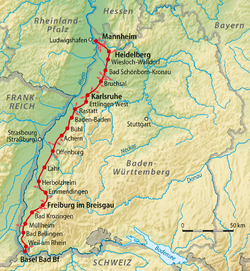Mannheim–Karlsruhe–Basle railway
| Rhine Valley Railway | |
|---|---|
 |
|
| Overview | |
| Native name | Rheintalbahn |
| Locale | Baden-Württemberg, Germany |
| Termini |
Mannheim Hbf Basel Bad |
| Line number |
|
| Technical | |
| Line length | 270.7 km (168.2 mi) |
| Track gauge | 1,435 mm (4 ft 8 1⁄2 in) standard gauge |
| Electrification | 15 kV/16.7 Hz AC overhead catenary |
| Operating speed | 250 km/h (160 mph) (max) |
| Route number |
|
The Mannheim–Karlsruhe–Basel railway is a double-track electrified mainline railway in the German state of Baden-Württemberg. It runs from Mannheim via Heidelberg, Bruchsal, Karlsruhe, Rastatt, Baden-Baden, Offenburg and Freiburg to Basel, Switzerland. It is also known as the Rhine Valley Railway (German: Rheintalbahn) or the Upper Rhine Railway (Oberrheinbahn).
The line was built as part of the Baden Mainline (Badische Hauptbahn). Between Mannheim and Rastatt it runs parallel to the Baden Rhine Railway (Rheinbahn). The Karlsruhe–Basel high-speed railway, called the Ausbau- und Neubaustrecke Karlsruhe–Basel in German (literally: "Upgraded and new line Karlsruhe–Basel"), has been under construction since April 1987. This includes upgrading the current line to four-tracks in places and the construction of new line elsewhere. It was originally envisaged as being completed in 2008, but no final date for completion is now envisaged (as of 2015).
The Mannheim–Basel railway is one of the most important routes in the Deutsche Bahn network.
The railway on the German side of the Rhine was financed and built by the Grand Duchy of Baden State Railway (Großherzogliche Badische Staatsbahn). At the enactment of the Baden law permitting the construction of the Baden main line on 28 March 1838, only the starting point in Mannheim and the end point in Basel had been determined. The route was determined by the Technischen Baukommission (“Technical Building Commission”), which was formed in 1837. It adopted as its basic aims that the construction cost should be as low as possible as was consistent with good running times and that the line should be built as straight as possible to connect the major cities. It decided that the should be built, if possible, in the Upper Rhine Plain. The first section between Mannheim and Heidelberg was opened in 1840 and the line was completed in several section to Basel until 1855. The first route designs provided for a route from Heidelberg via Schwetzingen to Karlsruhe. After the then third largest city in the Grand Duchy of Baden, Bruchsal learned of these plans, the Baden Parliament sat to consider a connection via Bruchsal and Durlach. On 2 January 1846, two trains ran into each other in St. Ilgen, a village near Leimen. One person died and 16 others were injured. This was one of the first fatalities in a rail accident in Germany.
...
Wikipedia
